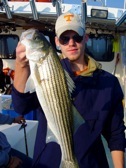 One of the most effective techniques for catching striped bass in the Chesapeake Bay is vertical jigging with light tackle. It can be done in both deep and shallow water and will produce when all other methods fail. Rockfish in the Bay typically station themselves near underwater structure where they wait to ambush bait-fish. Since they often don’t move much it’s necessary to present a lure exactly where they are holding. Jigging is the way to catch them.
One of the most effective techniques for catching striped bass in the Chesapeake Bay is vertical jigging with light tackle. It can be done in both deep and shallow water and will produce when all other methods fail. Rockfish in the Bay typically station themselves near underwater structure where they wait to ambush bait-fish. Since they often don’t move much it’s necessary to present a lure exactly where they are holding. Jigging is the way to catch them.
Basic vertical jigging technique requires stationing the boat directly over the fish. I never drop a jig unless I’ve either located fish on the finder, or feel confident that they’ll be nearby at any moment. Make no mistake, learning to find the fish is the hardest part of light tackle fishing.
High current locations are always best, but fish will also station themselves around underwater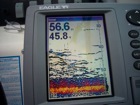 humps, ledges, wrecks or other structure. In the summer and fall, working birds will help you find the fish, but depending on birds can mean many sad days on the water. It’s far better to learn the habitat fish prefer and work those areas. Often the birds and breakers will be waiting for you when you arrive.
humps, ledges, wrecks or other structure. In the summer and fall, working birds will help you find the fish, but depending on birds can mean many sad days on the water. It’s far better to learn the habitat fish prefer and work those areas. Often the birds and breakers will be waiting for you when you arrive.
Once fish are located, it’s time to decide upon bait. There are two basic lure choices; metal jigs or soft plastic baits. I usually start with plastic but will often switch to metal, especially when bluefish are in the area. The lure should be heavy enough to allow you to feel the bottom at all times. A lure that is too light will not stay near the fish because it simply drifts up in the current. Drop the jig straight down. You should feel a definite “plop” when it hits the bottom. If you can’t feel the bottom, go to heavier bait.
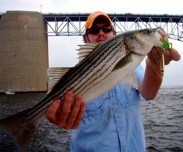 My favorite metal jigs are Hopkins Shortys and Stingsilvers. I sometimes make my own metal jigs out of inline sinkers, a technique
My favorite metal jigs are Hopkins Shortys and Stingsilvers. I sometimes make my own metal jigs out of inline sinkers, a technique
that will be discussed in a later article. Gold, silver, blue, and chartreuse are my colors of choice. A treble hook limits the action of the jig and increases the likelihood of tangling, so I don’t use them. I prefer single hooks 3/0 or larger, dressed with a small flash, either buck-tail or feather.
There are many good soft plastic baits available that will work well on the Bay. My favorite plastics for basic techniques are 6 inch or 10 inch Bass Kandy Delights (BKDs), 7 inch Bass Assassins, and 6 inch Mann’s Hardheads. I usually start with chartreuse before going to another color. A BKD is a lure produced locally and designed specifically for Chesapeake Bay rockfish. I especially like the larger version in the spring and fall. I prefer soft plastic lures with a long thin design for basic jigging techniques.
Weight is determined by the size of the jig head. As with metal jigs, match the weight of the lure to the current. You’ll want to use the lightest jig-head possible that will allow you to feel the
bottom on every drop. (Exceptions to this rule apply for suspended fish – see the advanced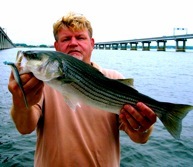 techniques article.) Make sure the lure is perfectly in line with the shaft of the hook. Any kinks or bends will cause it to spin or react unnaturally.
techniques article.) Make sure the lure is perfectly in line with the shaft of the hook. Any kinks or bends will cause it to spin or react unnaturally.
It’s possible to anchor over structure, but it’s generally more productive to position the boat up-current so that you drift back through the area where the fish are holding. Drifting causes the lure to move more naturally with the current. Turn off the engine whenever it’s safe to do so. Since it’s likely that either your boat or the water will be moving, the lure won’t stay right beneath you for very long. Position yourself in the boat so that you’re facing opposite the direction of the drift. A good way to remember your optimum position in the boat is, “if the wind’s in your face, you’re in the right place.”
After you’ve drifted by the area where the fish are holding, start the engine, reposition the boat, and repeat the drift. Once you get a feel for the drift and the bottom you’ll want to make adjustments to keep your lure on the bottom longer. This may mean casting slightly in to the drift so that you drift back over your lure. Once it gets behind you you’ll eventually loose contact with the bottom and need to retrieve the lure and cast again.
I prefer a baitcaster for jigging because it allows me to adjust quickly to changes on the bottom using only my thumb, but many anglers use spinning reels very effectively. For those new to light tackle jigging, its better to start with a spinning outfit. A relatively stiff rod is essential. A medium or medium heavy graphite rod with very little whip should do the trick.
My jigging reels are spooled with 10-20 pound-test braid and an 18 inch fluorocarbon leader. I look at the diameter of the line more than test strength. A thin line allows the lure to get to the bottom fast and doesn’t get carried along by the current. I often see the strike before I feel it, so I like bright visible colors. Mono doesn’t work well for vertical jigging because of the stretch. The strike may be transferred up the line to your rod tip at about the same time using mono, but the stretchiness of the line delays your hook-set back down to the lure. Quicken your reaction time by using braid.
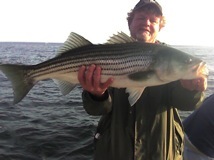 Proper presentation technique for basic vertical jigging is to drop the lure straight down. With a little practice, you’ll be able to tell whether you’re fishing over sand, mud, shells, or rocks just by the “plop” you feel when it hits the bottom. After the “plop,” immediately snap up, then allow the jig to flutter right back down to the plop again. The rod-snap can be critical because that’s what imparts action into the lure. Better light tackle fishermen develop a quick down and up so that there’s an audible noice similar to cracking a whip. Imagine that the rod tip is drawing a giant check mark, but don’t jerk up so far that it creates too much slack in the line. Just a quick snap is all that’s necessary.
Proper presentation technique for basic vertical jigging is to drop the lure straight down. With a little practice, you’ll be able to tell whether you’re fishing over sand, mud, shells, or rocks just by the “plop” you feel when it hits the bottom. After the “plop,” immediately snap up, then allow the jig to flutter right back down to the plop again. The rod-snap can be critical because that’s what imparts action into the lure. Better light tackle fishermen develop a quick down and up so that there’s an audible noice similar to cracking a whip. Imagine that the rod tip is drawing a giant check mark, but don’t jerk up so far that it creates too much slack in the line. Just a quick snap is all that’s necessary.
As the lure falls, try to keep any slack out of your line. It takes some practice, but it’s essential to keep the line tight because the fish almost always hit the jig when it is falling. Most fishermen who are new to jigging lower their rod tip too quickly so there’s too much slack in the line. Follow the lure’s descent slowly with your rod tip all the way back down to the bottom. You want to feel the weight of the lure as it falls. When it plops again, repeat the action.
Unlike top-water fishing when the fish almost catch themselves, a solid hook-set is essential when vertical jigging. Any change in the normal rise and fall of the lure requires you to give the rod a stiff jerk to firmly imbed the hook in the fish’s mouth. Concentration is essential. I have a hard time doing anything else, even talking when I’m jigging. As my dad taught me, you have to “think down the line.”
The most common strike is just a little “tap-tap,” like a tiny little minnow is pecking away. Set the hook immediately, it could be a trophy. At other times you might immediately feel the weight of the fish as you jerk back up. In that case, the hook may already be set. Bigger fish sort of slup or suck the jig in. With some practice it’s possible to tell something about the size of the fish by the nature of the strike. One of my favorite vertical jigging strikes occurs when the lure just stops falling. It often takes a while to register in my brain, “Hmmm, that didn’t drop back far enough.” Set the hook!
Striped bass usually take the jig by the head first. The only exception occurs when fish occasionally chase the lure back to the boat, then they may hit the tail. Once they get the jig in their mouth, they start to turn it around to swallow it tail first. That’s usually when they figure out the lure is artificial and blow it back out. Often, the fish will attack and spit out the lure before the fisherman even knows anything happened. Sometimes you get lucky and don’t have to do anything because the lure catches in the fish’s mouth when it blows it out. For that reason it’s important to keep you hooks very sharp. Sharp hooks will catch a lot of fish you never would’ve known were there. With a sensitive rod, light braided line, and a quick reaction, you can feel the strike and stay ahead of the fish by setting the hook before it spits it out.
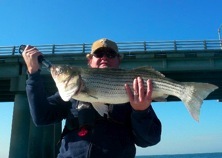 I don’t think the learning curve for vertical jigging is all that steep. Almost anyone can do it at the basic level. The hardest part of the process is finding the fish and gaining confidence in your presentation. My favorite upper-bay verticle jigging locations are hard oyster shell bottoms. These include the ledge at Podickory Point, the area near the mouth of the Chester river, the humps called the “Knolls,” and “Man-O-War Shoals.” Farther south there’s good bottoms to jig near Chesapeake Beach, Breezy Point, Parker’s Creek, and the mouth of the Choptank River.
I don’t think the learning curve for vertical jigging is all that steep. Almost anyone can do it at the basic level. The hardest part of the process is finding the fish and gaining confidence in your presentation. My favorite upper-bay verticle jigging locations are hard oyster shell bottoms. These include the ledge at Podickory Point, the area near the mouth of the Chester river, the humps called the “Knolls,” and “Man-O-War Shoals.” Farther south there’s good bottoms to jig near Chesapeake Beach, Breezy Point, Parker’s Creek, and the mouth of the Choptank River.
I also like jigging around the rock piles and pilings at the Bay Bridge. I often refer to this area as “LTJ University,” because there is an abundance of small rockfish there in the spring and fall. The high currents and rocky bottom make mistakes unforgivable. You’ll either learn to jig here and catch fish, or loose all your bait trying! In other articles I will discuss more advanced jigging techniques and proven methods for catching fish at individual locations.
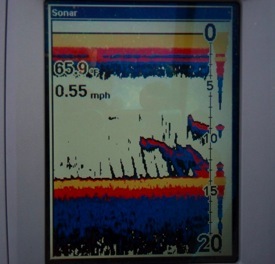 I’ll close with a fish finder picture of a fish being caught on a bottom bouncing jig. Look at it as about 15 seconds of fishing. The verticle lines represent each snap of the lure while the heavier blobs are waiting fish. Good luck making it happen. I’ll see you on the water!
I’ll close with a fish finder picture of a fish being caught on a bottom bouncing jig. Look at it as about 15 seconds of fishing. The verticle lines represent each snap of the lure while the heavier blobs are waiting fish. Good luck making it happen. I’ll see you on the water!




Do you have a reel recommendation for both flounder and light tackle jigging in the Bay and Potomac/Patuxent rivers. I want to pair it with a 6’6″ rod with medium action.
I assume you’re looking for a spinning reel. A lot of guys really like the Shimano Stradic series because of the advanced drag system and durability. The 2500 is plenty big enough for the Bay. I think any reel in that size range will work out okay. The biggest issue is durability. Even the relatively mild salinitiy in the Bay will cause reels to fail quickly.
Could you explain why the style “9” Shad Head Jig or Shad Head Jig is the most popular for LTJ? Would using a bucktail or other weighter jig change the action of the lure?
Check Your Google Pagerank – Website Ranking Checker…
Check your Google Pagerank, backlinks, listed webpages on search engine in order to find social links….
Kopper Live Target company worked out two classical top water frog fishing lures,they are hot selling in the whole world
All the backlinks you need…
[…]Light Tackle Jigging – The Basics | Chesapeake Light Tackle[…]…
Excellent article. Best how to Light Tackle how to info I’ve seen…even in books I’ve purchased. Thanks.
apartment near ucla for rent bv…
Light Tackle Jigging – The Basics | Chesapeake Light Tackle…